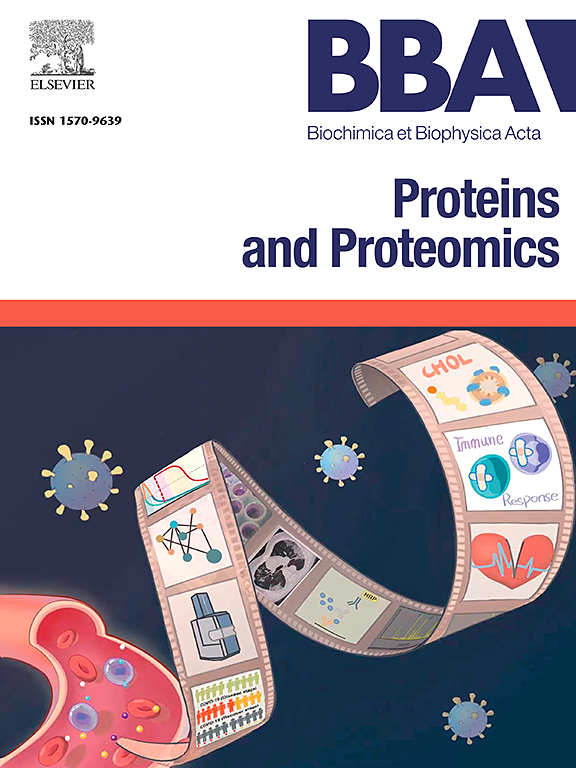人线粒体焦磷酸酶hPPA2:影响其功能因素的体外和计算机研究
IF 2.3
4区 生物学
Q3 BIOCHEMISTRY & MOLECULAR BIOLOGY
Biochimica et biophysica acta. Proteins and proteomics
Pub Date : 2025-06-11
DOI:10.1016/j.bbapap.2025.141085
引用次数: 0
摘要
人类编码线粒体无机焦磷酸酶hPPA2的核基因PPA2的双等位基因突变导致线粒体功能障碍,导致严重的心脏病理。这种蛋白质催化依赖Mg2+的焦磷酸盐水解,焦磷酸盐是许多生物合成反应的副产物,从而为这些反应提供热力学拉动。为了更好地理解PPA2基因突变引起的线粒体功能障碍的分子机制,需要详细描述hPPA2的代谢作用。在这项工作中,我们研究了一组代谢物以及其他因素对重组hPPA2活性的体外影响。这项研究补充了对观察到的模式的可能机制的计算机评估。我们证明,在线粒体基质典型的Mg2+浓度下,hPPA2在欠饱和状态下工作,因此改变Mg2+浓度的调节因子将对hPPA2的活性产生重大影响。我们还证明了hPPA2活性受半胱氨酸残基氧化还原状态的调节。质谱分析揭示了4-羟基- hg -苯甲酸酯修饰的4个Cys残基,以及hPPA2单体内形成的SS桥。最后,我们发现选定的代谢物包括中枢代谢的中间体影响hPPA2的活性。对hPPA2的硅分析允许对观察到的特性进行结构洞察。特别值得关注的是一个w环,它是来自动物的PPA2蛋白所特有的,与来自动质体的酸钙体可溶性焦磷酸酶共享,可能参与与小分子效应物的相互作用。本文章由计算机程序翻译,如有差异,请以英文原文为准。
Human mitochondrial pyrophosphatase hPPA2: In vitro and in silico study of the factors affecting its function
Biallelic mutations in a nuclear gene PPA2 in human encoding mitochondrial inorganic pyrophosphatase hPPA2 cause mitochondrial disfunctions leading to severe cardiac pathology. This protein catalyzes a Mg2+-dependent hydrolysis of pyrophosphate, a by-product of many biosynthetic reactions, thereby providing a thermodynamic pull for these reactions. In order to better understand molecular mechanisms of mitochondrial disfunction caused by mutations in PPA2 gene, detailed characterization of a metabolic role of hPPA2 is required. In this work, we study the in vitro effects of a panel of metabolites, as well as other factors, on the recombinant hPPA2 activity. This study is complemented with the in silico assessment of possible mechanisms of observed patterns. We demonstrate that at Mg2+ concentrations typical for the mitochondrial matrix hPPA2 works at under-saturation and therefore the regulatory factors changing Mg2+ concentration will have a significant impact on hPPA2 activity. We also demonstrate that hPPA2 activity is regulated by a redox state of cysteine residues. Mass-spectrometry analysis reveals four Cys residues modified by 4-hydroxy-Hg-benzoate, as well as an S![]() S bridge formation within an hPPA2 monomer. Finally, we found that selected metabolites including intermediates of central metabolism affect hPPA2 activity. In silico analysis of hPPA2 allows a structural insight into the observed properties. Of a special interest is an W-loop, unique for PPA2 proteins from animals and shared with acidocalcisomal soluble pyrophosphatases from kinetoplastids, that may be involved in interaction with small-molecule effectors.
S bridge formation within an hPPA2 monomer. Finally, we found that selected metabolites including intermediates of central metabolism affect hPPA2 activity. In silico analysis of hPPA2 allows a structural insight into the observed properties. Of a special interest is an W-loop, unique for PPA2 proteins from animals and shared with acidocalcisomal soluble pyrophosphatases from kinetoplastids, that may be involved in interaction with small-molecule effectors.
求助全文
通过发布文献求助,成功后即可免费获取论文全文。
去求助
来源期刊
CiteScore
8.00
自引率
0.00%
发文量
55
审稿时长
33 days
期刊介绍:
BBA Proteins and Proteomics covers protein structure conformation and dynamics; protein folding; protein-ligand interactions; enzyme mechanisms, models and kinetics; protein physical properties and spectroscopy; and proteomics and bioinformatics analyses of protein structure, protein function, or protein regulation.

 求助内容:
求助内容: 应助结果提醒方式:
应助结果提醒方式:


